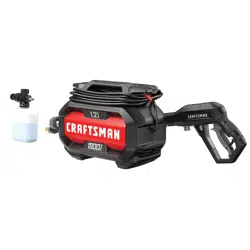Loading ...
Loading ...
Loading ...

ENGLISH
6
MAINTENANCE
WARNING: To reduce the risk of serious personal
injury, turn unit off and disconnect it from
power source before making any adjustments or
removing/installing attachments or accessories.
An accidental start-up can causeinjury.
Cleaning
WARNING: Blow dirt and dust out of all air vents with
clean, dry air at least once a week. To minimize the risk
of eye injury, always wear ANSI Z87.1 approved eye
protection when performingthisprocedure.
WARNING: Never use solvents or other harsh
chemicals for cleaning the non-metallic parts of
the tool. These chemicals may weaken the plastic
materials used in these parts. Use a cloth dampened
only with water and mild soap. Never let any liquid
get inside the tool; never immerse any part of the tool
into aliquid.
Nozzle (Fig. A)
If the nozzle becomes clogged with foreign materials,
such as dirt, excessive pressure may develop. If the
nozzle becomes partially clogged or restricted, the pump
pressure will pulsate. Clean the nozzle immediately using
the nozzle cleaner.
1. Shut OFF the pressure washer unit
8
and turn OFF the
watersupply.
2. Pull trigger
7
on spray handle
4
to relieve any
waterpressure.
3. Remove the nozzle from the spray wand
2
by pulling
the quick connect collar
3
toward the spraywand.
4. Using the spray tip cleaning tool, unclog any debris from
thenozzle.
5. Run water from a faucet or garden hose through
thenozzle.
Pressure Washing
Preparing Surface for Cleaning
• Remove objects from the area which could create a
hazard such as children's toys or outdoor furniture.
• Ensure that all doors and windows are closed tight.
Protect all plants and trees in the adjacent area with a
drop cloth ensuring that they will not be harmed by
any overspray.
• Pre-rinse cleaning area with fresh water.
• Use only detergents formulated for pressure washers.
• Always test detergent in an inconspicuous area before use.
Preparing Pressure Washer Unit for Use (Fig. A)
DANGER: Risk of fluid injection and laceration.
When using the high-pressure setting, DO NOT allow
the high-pressure spray to come in contact with
unprotected skin, eyes, or with any pets or animals.
Serious injury willoccur.
CAUTION: Before operation:
- Connect the water supply to the pressure washer . For
instructions on connecting the water supply to the
pressure washer, please refer to Attaching Garden
Hose under Assembly andAdjustments.
- Connect the high pressure hose to the pressure washer
and the pressure wand. For instructions on connecting
the high pressure hose to the pressure washer and
pressure wand, please refer to Attaching High
Pressure Hose under Assembly andAdjustments.
Preparing Spray Handle
IMPORTANT: Before turning on the pressure washer unit,
disengage the trigger lock-off
6
and squeeze the trigger
7
.
Hold the trigger for 30 seconds to purge the system of air. If
air is still found in the water stream, continue to run water
through the sprayhandle.
1. Disengage the trigger lock-off
6
.
2. Squeeze the trigger
7
.
Cleaning a Surface
• To start the pressure washer, press the ON button
9
.
• The best angle for spraying water against a cleaning
surface is 45°. Spraying head on tends to cause dirt
particles to imbed in the surface. When working on
vertical surfaces, it is best to apply detergent starting at
the bottom and working upwards which will prevent
the detergent from sliding down and causing streaks.
To disengage the spray handle, release thetrigger.
NOTE: Excessive pump pressure may be the result of a
clogged nozzle or brass coupling. Always turn OFF the
pressure washer unit and unplug the unit before attempting
to unclog a nozzle or brasscoupler.
Moving the Pressure Washer (Fig. A)
1. Shut OFF the pressure washer unit
8
and turn OFF the
watersupply.
2. Point the spray wand
2
in a safe direction and pull the
trigger
7
to release remaining waterpressure.
3. When the spray wand is completely empty, carry the
pressure washer by the handle
11
.
Shutdown (Fig. A)
1. To stop the pressure washer, press the OFF button
10
and unplug the cord from the outlet.
2. Turn OFF water at the faucet.
3. Discharge residual pressure by squeezing the trigger
7
until no more water comes out of the spray wand
2
.
4. Engage the spray handle lock-off
6
.
5. Disconnect the garden hose from the water intake
18
.
6. Disconnect the high pressure hose
1
from the high
pressure water outlet
17
and drain hose.
Loading ...
Loading ...
Loading ...
